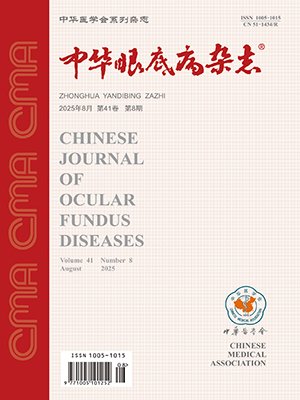| 1. |
Goktas S, Basaran A, Sakarya Y, et al. Measurement of choroid thickness in pregnant women using enhanced depth imaging optical coherence tomography[J]. Arq Bras Oftalmol, 2014, 77(3): 148-151. DOI: 10.5935/0004-2749.20140038.
|
| 2. |
Gaillard R, Bakker R, Willemsen SP, et al. Blood pressure tracking during pregnancy and the risk of gestational hypertensive disorders: the Generation R Study[J]. Eur Heart J, 2011, 32(24): 3088-3097. DOI: 10.1093/eurheartj/ehr275.
|
| 3. |
Sathish S, Arnold JJ. Bilateral choroidal ischaemia and serous retinal detachment in pre-eclampsia[J]. Clin Experiment Ophthalmol, 2000, 28(5): 387-390. DOI: 10.1046/j.1442-9071.2000.00342.x.
|
| 4. |
Introini U, Casalino G, Cardani A, et al. Intravitreal bevacizumab for a subfoveal myopic choroidal neovascularization in the first trimester of pregnancy[J]. J Ocul Pharmacol Ther, 2012, 28(5): 553-555. DOI: 10.1089/jop.2012.0067.
|
| 5. |
Jouve L, Akesbi J, Nordmann JP. Safety and efficacy of ranibizumab for pregnant women in idiopathic choroidal neovascularization[J]. Acta Ophthalmol, 2015, 93(7): 97-98. DOI: 10.1111/aos.12611.
|
| 6. |
洪婷婷, 马子程, 付秀稳, 等. 健康孕妇和子痫前期孕妇黄斑中心凹视网膜厚度和黄斑中心凹下脉络膜厚度对比观察[J]. 中华眼底病杂志, 2017, 33(6): 584-586. DOI: 10.3760/cma.j.issn.1005-1015.2017.06.007.Hong TT, Ma ZC, Fu XW, et al. Comparison of central foveal thickness and subfoveal choroidal thickness in healthy pregnancy and preeclampsia[J]. Chin J Ocul Fundus Dis, 2017, 33(6): 584-586. DOI: 10.3760/cma.j.issn.1005-1015.2017.06.007.
|
| 7. |
Naderan M, Jahanrad A. Topographic, tomographic and biomechanical corneal changes during pregnancy in patients with keratoconus: a cohort study[J]. Acta Ophthalmol, 2017, 95(4): 291-296. DOI: 10.1111/aos.13296.
|
| 8. |
Sethi HS, Naik M, Gupta VS. Management of glaucoma in pregnancy: risks or choices, a dilemma?[J]. Int J Ophthalmol, 2016, 9(11): 1684-1690. DOI: 10.18240/ijo.2016.11.24.
|
| 9. |
李笑天. 妊娠诊断[M]//谢幸, 苟文丽. 妇产科学. 8版. 北京: 人民卫生出版社, 2013: 42-46.Li XT. Diagnosis of pregnancy[M]//Xie X, Gou WL. Obstetrics and Gynaecology. 8th ed. Beijing: People's Medical Publishing House, 2013: 42-46.
|
| 10. |
Chen HC, Newsom RS, Patel V, et al. Retinal blood flow changes during pregnancy in women with diabetes[J]. Invest Ophthalmol Vis Sci, 1994, 35(8): 3199-3208.
|
| 11. |
Takahashi J, Kado M, Mizumoto K, et al. Choroidal thickness in pregnant women measured by enhanced depth imaging optical coherence tomography[J]. Jpn J Ophthalmol, 2013, 57(5): 435-439. DOI: 10.1007/s10384-013-0265-5.
|
| 12. |
Benfica CZ, Zanella T, Farias LB, et al. Comparative analysis of choroidal thickness in third trimester pregnant women[J]. Int J Retina Vitreous, 2018, 4: 6. DOI: 10.1186/s40942-018-0108-0.
|
| 13. |
Sayin N, Kara N, Pirhan D, et al. Subfoveal choroidal thickness in pre-eclampsia: comparison with normal pregnant and nonpregnant women[J]. Semin Ophthalmol, 2014, 29(1): 11-17. DOI: 10.3109/08820538.
|
| 14. |
Ataş M, Açmaz G, Aksoy H, et al. Evaluation of the macula, retinal nerve fber layer and choroid in preeclampsia, healthy pregnant and healthy non-pregnant women using spectral-domain optical coherence tomography[J]. Hypertens Pregnancy, 2014, 33(3): 299-310. DOI: 10.3109/10641955.
|
| 15. |
Kara N, Sayin N, Pirhan D, et al. Evaluation of subfoveal choroidal thickness in pregnant women using enhanced depth imaging optical coherence tomography[J]. Curr Eye Res, 2014, 39(6): 642-647. DOI: 10.3109/02713683.
|
| 16. |
Dadaci Z, Alptekin H, Oncel Acir N, et al. Changes in choroidal thickness during pregnancy detected by enhanced depth imaging optical coherence tomography[J]. Br J Ophthalmol, 2015, 99(9): 1255-1259. DOI: 10.1136/bjophthalmol-2014-306343.
|
| 17. |
Quillen DA, Gass DM, Brod RD, et al. Central serous chorioretinopathy in women[J]. Ophthalmology, 1996, 103(1): 72-79. DOI: 10.1016/s0161-6420(96)30730-6.
|
| 18. |
Perkins SL, Kim JE, Pollack JS, et al. Clinical characteristics of central serous chorioretinopathy in women[J]. Ophthalmology, 2002, 109(2): 262-266. DOI: 10.1016/s0161-6420(01)00951-4.
|
| 19. |
Ulusoy DM, Duru N, Ataş M, et al. Measurement of choroidal thickness and macular thickness during and after pregnancy[J]. Int J Ophthalmol, 2015, 8(2): 321-325. DOI: 10.3980/j.issn.2222-3959.
|
| 20. |
Demir M, Oba E, Can E, et al. Foveal and parafoveal retinal thickness in healthy pregnant women in their last trimester[J]. Clin Ophthalmol, 2011, 5: 1397-1400. DOI: 10.2147/OPTH.S23944.
|
| 21. |
Cankaya C, Bozkurt M, Ulutas O. Total macular volume and foveal retinal thickness alterations in healthy pregnant women[J]. Semin Ophthalmol, 2013, 28(2): 103-111. DOI: 10.3109/08820538.
|




